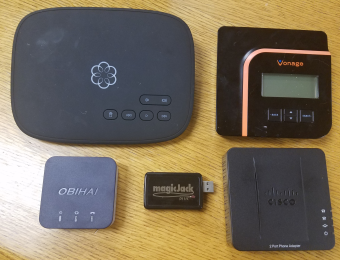We reduced our firm’s $160 per month phone bill for four telephone lines to 85¢ per month. Continue reading “Reducing the cost of four telephone lines from $160 per month to 85¢ per month”
Picking a VOIP analog telephone adapter
A good VPN router with dual-band wifi and good tech support

The landscape for VPN routers has changed over the years. As of a few years ago, sophisticated VPN routers with IPSEC were ethernet-only. Continue reading “A good VPN router with dual-band wifi and good tech support”
Identify this music-on-hold song and win a prize
Okay folks here is a chance to win a free digital multimeter.
What prompts this is that I keep hearing a particular music-on-hold (MOH) song on lots of different tech support and customer service systems. So I figure this song is probably one of the standard royalty-free MOH songs that comes with the Asterisk phone system or something. You can hear the song here.
To win the prize, post a comment with a link to the web page where this particular MOH song can be downloaded.
hosting multiple WordPress sites on one Synology box
I’ve worked out how to host multiple WordPress sites on a single Synology box. You can read the how-to article here. Please post comments and suggestions and corrections in the comments below.
Celebrate World Backup Day today
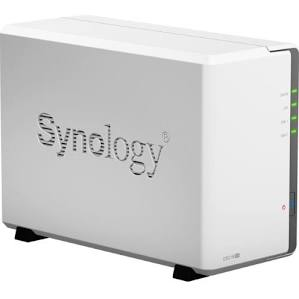 I just learned that today is World Backup Day. I’ll describe the no-monthly-charge backup system that I recommend nowadays to everybody. Continue reading “Celebrate World Backup Day today”
I just learned that today is World Backup Day. I’ll describe the no-monthly-charge backup system that I recommend nowadays to everybody. Continue reading “Celebrate World Backup Day today”
Smarter battery backup communications nowadays
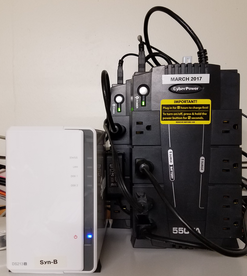
When I started my law firm (almost 25 years ago now), the connection from a UPS (uninterruptible power supply or “battery backup”) to a server was by means of a 9-pin RS-232 serial cable. The signals were simple binary values — power fail, low battery, and UPS shutdown.
Nowadays the connection from a UPS to a server is smarter, as I will describe. Continue reading “Smarter battery backup communications nowadays”
A home-improvement project — USB outlets
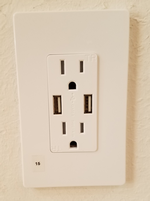 Here’s a nice home-improvement project — installing some USB receptacles around the house. You’ve used outlets like this in hotels and airports. Why not enjoy the convenience of such outlets in your own home?
Here’s a nice home-improvement project — installing some USB receptacles around the house. You’ve used outlets like this in hotels and airports. Why not enjoy the convenience of such outlets in your own home?
A rainy-day project – labeling electrical outlets
 Here’s a fun rainy-day project for those visiting nieces and nephews – labeling the electrical outlets. A first person is stationed at the circuit breaker panel. A second person is roaming the house, carrying a label maker and a lamp. These people are using walkie-talkies, if needed, or better yet, if they have amateur radio licenses, ham radio handy-talkies. The lamp is plugged into an outlet and is turned on. The person at the circuit breaker panel switches off the breakers one by one until it is determined which circuit breaker powers the outlet. A label is printed and applied to the cover plate of the outlet. (For example in this case it is breaker number 15.) The process is repeated until every electrical outlet has been labeled.
Here’s a fun rainy-day project for those visiting nieces and nephews – labeling the electrical outlets. A first person is stationed at the circuit breaker panel. A second person is roaming the house, carrying a label maker and a lamp. These people are using walkie-talkies, if needed, or better yet, if they have amateur radio licenses, ham radio handy-talkies. The lamp is plugged into an outlet and is turned on. The person at the circuit breaker panel switches off the breakers one by one until it is determined which circuit breaker powers the outlet. A label is printed and applied to the cover plate of the outlet. (For example in this case it is breaker number 15.) The process is repeated until every electrical outlet has been labeled.
For extra credit, a third person can sketch a map of the house and the outlet locations plotted on the map. The map can then be posted next to the circuit breaker panel.
When the project is finished, everybody can make popcorn and watch a movie. A fun activity for the entire family!
Learning about “wifi calling”
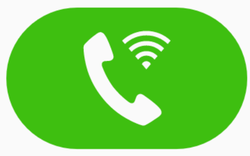 Today’s blog article is a “tech” article and it is a “trademarks” article. The main point of this blog article is that probably you should activate “wifi calling” on your mobile phone, if you have not already done so.
Today’s blog article is a “tech” article and it is a “trademarks” article. The main point of this blog article is that probably you should activate “wifi calling” on your mobile phone, if you have not already done so.
For most mobile telephone customers in the US, wifi calling has only been available for a few months. So a reader of this blog may be forgiven for having failed to activate this service before now.
What is wifi calling? Continue reading “Learning about “wifi calling””

